Clematis Westerplatte - important information about the variety
The perennial clematis Westerplatte, bred by the Polish breeder Stefan Franczak in 1994, became widespread in many European countries, and later in our country. Consider the main characteristic of the variety, planting rules and care features.
- Description of the variety
- Landing rules
- Place and soil
- Seedling preparation
- Landing technique
- Care
- Watering
- Loosening and mulching
- Top dressing
- Pruning
- Preparing for winter
- Reproduction methods
- Cuttings
- By dividing the rhizome
- Stem layering
- Diseases and pests
- Rust
- Powdery mildew
- Wilt (wilting)
- Gray rot
- Spider mites, aphids, caterpillars
- Nematode
- Rodents
- Application in garden design
- Gardeners reviews
- Useful videos
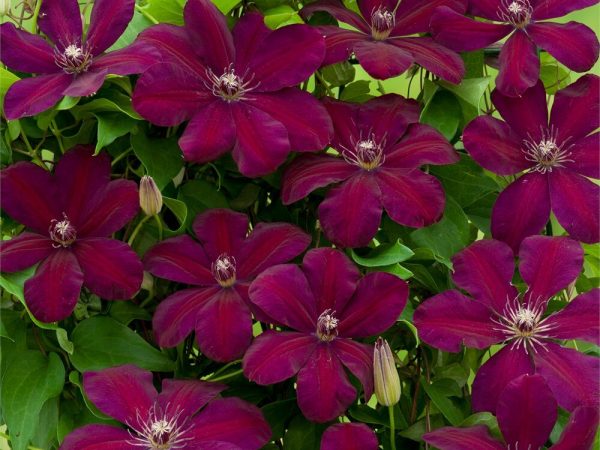
Clematis westerplatte
Description of the variety
The Latin name is clematis westerplatte.
You can distinguish this shrub vine by the following description:
- twisty and long shoots up to 3 m;
- leaves are oval or rounded with a sharp tip, size 5-6x3-4 cm;
- inflorescences are large, from 10 to 16 cm in diameter, consist of 5-6 petals of scarlet or deep red color, anthers are burgundy, stamens are cream or yellow;
- buds are formed on the branches of the current and last year;
- the root system is well-branched, superficial.
Clematis blooms twice a season - the first wave from mid-May to June 15-18, the second from the beginning to the end of July.
This perennial vine has good frost resistance (zone 4), high resistance to various viral and fungal infections, provided it is well cared for.
Landing rules
Depending on the region, the landing time is different:
- in zones with a continental and harsh climate, they are planted in mid or late April;
- in the south and in the middle lane - in spring and autumn (until the first half of September).
It is important that the soil warms up to a temperature of 10-12 ° C and the last frosts pass.
Place and soil
You need to grow clematis in an area with good access to sunlight in the morning and evening. In the shade, they grow poorly - the leaves turn pale, the inflorescences become smaller and not so bright. When planted in the sun, foliage and flowers fade quickly.
This vine requires support. You can plant it near the walls of a house or other building, making a small indent - 50 cm. So the root system will fully develop. The optimum depth of groundwater is 2.5 m.
The soil should be light, with neutral acidity, well-drained and rich in nutrients.
When planting on loam, sprinkle with sand, vermiculite or perlite - 20 kg / m². If you plan to grow on sandy loam, add a couple of buckets of clay. If necessary, add a deoxidizer (chalk, slaked lime, dolomite flour or calcite) - 400 to the same area.
Then they carry out deep digging, leveling and watering.
Seedling preparation
Clematis Westerplatte seedlings are sold in gardening shops or nurseries. When choosing a young bush, carefully examine its crown - there should be no signs of disease and pests on it.
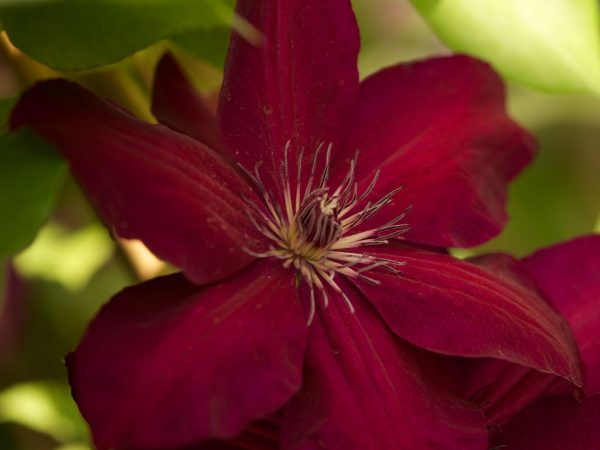
Westerplatte clematis pruning
Buy grown bushes that have several stems with leaves. Usually they are in containers or with an earthen lump.
Before planting, the pot is crumpled to facilitate the extraction of the roots. Gently transferred into a container with water and saturated with moisture for two hours. Then the roots are trimmed 2-3 cm in length to stimulate the growth of new processes after transplantation.
Landing technique
The pit is prepared in two weeks so that the nutrients have time to settle. The approximate dimensions are 50x60 cm.When group cultivation, a distance of at least 1 m is maintained.
Planting stages:
- the hole is filled 1/3 of the depth with drainage - a mixture of pebbles, crushed stone and brick chips;
- then half of the fertile composition is poured from a bucket of dug earth, 5 kg of compost (humus) with the addition of 300 g of ash, 50 g of superphosphate and 40 g of potassium sulfate;
- the roots are lowered in the center of the hole, sprinkled with soil mixture, compacted, watered - consumption per shrub is 20 liters;
- at the end, mulch with sawdust, peat or compost;
- tied to a support - trellis, arch, pergola or other structure.
If a seedling with lignified stems, then the basal neck must be deepened by 10-12 cm. In the future, many buds will appear on the underground part, from which young twigs will grow. When planting a bush with green shoots, a deepening is not desirable, otherwise the plant will quickly rot and die.
In the first two weeks, you need to shade from the scorching sun at lunchtime. Use burlap or agrofiber.
Care
Watering
For successful rooting, a young liana is watered every day - 10 liters at a time. This will help it take root faster and begin to build up green mass.
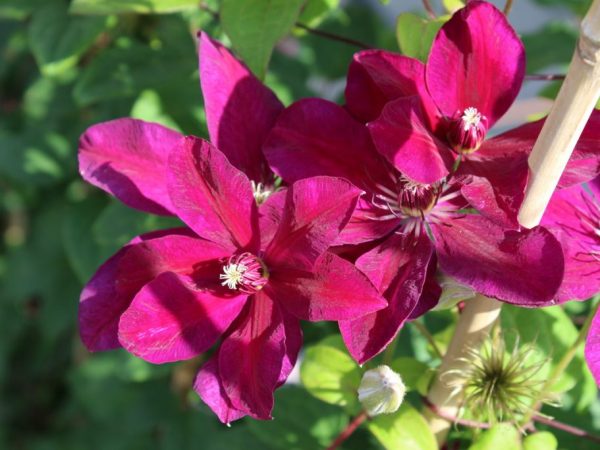
Clematis westerplatte variety description photo
Further watering is necessary as the soil dries out to a depth of 5-6 cm. If the summer is rainy, it is not necessary to moisten it, since the roots will begin to rot from excess moisture. Be sure to moisturize at the beginning of spring, before flowering, after its end and in the fall, when the vine will drop its foliage.
They use settled and warm water to eliminate the risk of freezing and rotting of the root system.
On hot days, they are irrigated with water, which helps to preserve its decorative effect and prevent wilting. The procedure is carried out in the evening.
Loosening and mulching
The day after watering, the soil is loosened to maintain its moisture and breathability. At the same time, weed shoots are removed, the soil is weeded between the bushes.
Then a thick layer of sawdust, peat or compost mulch is added to protect the roots from drying out.
To avoid overheating and rapid drying of the surface roots, stunted flowers - marigolds or calendula - can be planted in the near-stem zone.
Top dressing
A balanced diet provides the bushes with high immunity against diseases, lush flowering and good frost resistance.
They begin to fertilize in the third year of cultivation according to the following scheme:
- in early spring, the near-trunk circle is watered with a solution of urea, nitrophoska or azofoska - 15 g is dissolved in 10 liters of water;
- at the budding stage, superphosphate and potassium sulfate are introduced - 1 tbsp each. l. on a bucket of water;
- in the fall, when the shrub leaves the foliage, rotted manure or compost is embedded in the trunk circle.
To speed up the process of assimilation of nutrients, after each fertilization, abundant watering is carried out.
Pruning
This plant belongs to the second pruning group, so it is carried out in two stages:
- When last year's branches bloom, dry flowers are cut on them and cut to 3-5 buds. If the crown is thickened, some shoots can be cut into a ring.
- After the flowering of the young growth, the dried buds are removed, the stems are cut to a third of the length.
Also, throughout the growing season, diseased parts that are frozen, dried, damaged by diseases or winds are cut off.
A well-sharpened and disinfected secateurs are used for this procedure. After it is carried out, it is irrigated with a solution of copper sulfate.
Preparing for winter
The Westerplatte variety has good frost resistance, but it needs to be insulated for the first three years.
These works begin on the eve of autumn frosts. First, they spud with peat, last year's manure, sawdust.
The twigs are tied into a bunch, bent to the ground, fixed with brackets, covered with fallen leaves, spruce branches are laid on top. Alternatively, burlap or agrofibre can be used as a cover for the crown.
The insulation material is removed in the spring, when the last frosts have passed and the temperature reaches 12-15 ° C.
Reproduction methods
In modern horticulture, several methods are used to successfully breed this vine. Each one gives a good result, subject to all the rules of cultivation.
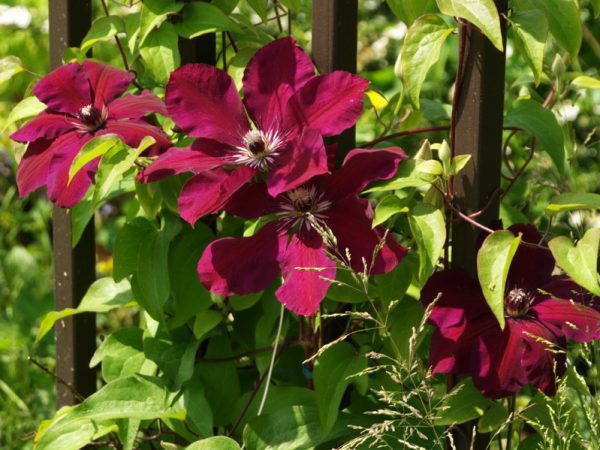
Clematis westerplatte
Cuttings
Shoots of the current year from the tops of lignified stems will do. Cuttings with two internodes, buds and leaves are chosen. At the bottom, the foliage is cut off, then dipped into one of the root formation stimulant for an hour.
They are planted in a seedling box filled with a peat-sand mixture. The planting depth is 3-4 cm. The plantings are moistened, covered with foil, placed in a warm place with diffused daylight.
Every day they are ventilated, as the substrate dries up, they are watered. As soon as they release new leaves, the shelter is removed, and they continue to look after for another month. Then they are transplanted to the site in the same way as purchased bushes.
By dividing the rhizome
They are engaged in such reproduction in the fall. Use old bushes that need to be rejuvenated. They are watered abundantly, dug up, and dipped in a basin of water to wash off the earth.
Dried, cut into pieces with a garden shovel or knife. Each section should have one shoot with buds and roots. Places of cuts are sprinkled with charcoal, then seated separately.
Stem layering
This is one of the easiest breeding methods for hasty breeding, which is used in the fall after leaf fall.
Choose a flexible, lignified twig that is close to the ground. It is lowered into a previously dug groove to a depth of 5-6 cm. It is sprinkled with a nutritious composition of humus, peat and sand mixed in equal amounts.
A week before the onset of persistent cold weather, they are covered with fallen leaves or sawdust so that the layers do not freeze over the winter.
In the spring, when the snow melts and the last frosts pass, the twig is dug up, cut off from the mother bush. Divide into parts so that each has roots. They are planted in a garden or flower garden according to the above described scheme.
Diseases and pests
If the rules of agricultural technology are violated, this perennial vine can get sick and be invaded by various parasites.
Rust
Fungal infection manifests itself as red or brown raised growths on the surface of stems and leaves. First, the diseased areas are cut out, then the bush is treated with Ridomil gold, Bordeaux liquid or copper sulfate.
Powdery mildew
The appearance is evidenced by a whitish bloom on foliage and flowers. Over time, it becomes oily, the affected parts darken, die off.
In the fight against infection, fungicides are used - Topaz, Skor or Hom.
Wilt (wilting)
This disease, which leads to the rapid wilting and drying of the crown, cannot be cured. Stems and foliage quickly lose turgor, which causes the death of the entire bush. It is dug out to avoid contamination by nearby growing flowers. The place of growth is spilled with a solution of copper sulfate or potassium permanganate.
Gray rot
It manifests itself in the form of brown spots with a grayish bloom on the surface of leaves and shoots. The diseased parts are cut out, then the crown is irrigated with Fundazol or Azocene.
Spider mites, aphids, caterpillars
They feed on tissue juices, cause curling, drying out and falling off of leaves, flowers and buds. At the initial stage of infection, you can use folk remedies - spray with an ash and soap solution, infusion of onions, garlic or tobacco.
If these drugs do not help, they resort to chemistry - irrigate with Aktara, Aktellik or Match.
Nematode
It affects the root system, clogs blood vessels and prevents the access of oxygen, moisture and nutrients. Later, the entire crown withers and dries. It is difficult to detect a nematode; in most cases, clematis dies. Therefore, at the first sign of infection, the shrub is dug up and burned. The place of its growth is spilled with copper sulfate.
Rodents
They love to feast on stems and roots. To avoid damage, sprinkle the trunk circle with special poison or set traps.
Application in garden design
This large-flowered liana with bright and lush blooms has become widespread in modern design:
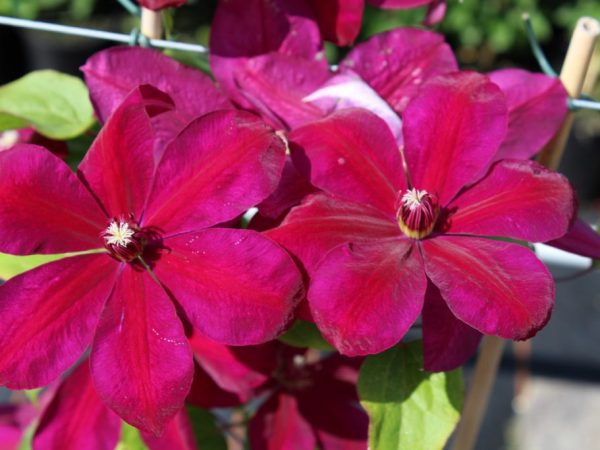
Clematis Westerplatte variety description
- used as a tapeworm - planted next to an arch, a gazebo, a terrace;
- used to decorate other vertical surfaces - pergolas, pillars;
- the shrub looks colorful in group plantings in combination with different varieties of clematis, undersized decorative deciduous plants;
- grown along the fence, creating a lush and vibrant hedge.
Gardeners reviews
Thanks to its unpretentious care, good frost resistance and repeated flowering, this variety has won the hearts of many flower growers:
- successful reproduction in separate parts makes it possible to independently breed new seedlings with all the signs of the mother bush;
- with proper care and attention, you can achieve the highest decorative effect and double flowering;
- successfully takes root on any type of soil with the introduction of the necessary nutrients;
- gets along well with different vegetation in the garden, which allows you to use the shrub in the most unusual and original compositions.

